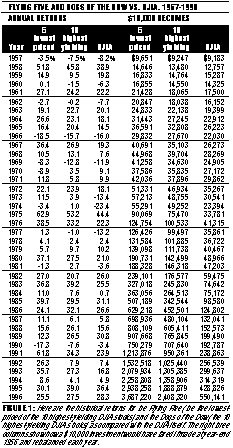THEORY
New Tricks With The Dogs Of The Dows
by Mark Vakkur
The Dogs of the Dow, a popular strategy based on purchasing the highest-yielding stocks each year, is reviewed here using a longer lookback period than originally used, as well as detailed analyses of the risks and rewards.
In Beating the Dow, Michael O'Higgins and John Downes outlined two high-yield strategies that achieve substantially greater returns than the Dow Jones Industrial Average (DJIA) with less risk. Here's a statistical analysis of these strategies, extending the study period back to 1957. The two main strategies to analyze the DJIA are simple. Each year, buy equal dollar amounts of either the 10 DJIA stocks with the highest yield (the "Dogs of the Dow") or the five lowest-priced of the 10 highest-yielding (the "Flying Five") and hold for one year. One year later, re-sort the Dow industrials and make any necessary purchases or sales so that you hold equal dollar amounts of the indicated stocks. Total investment time: about 15 minutes a year.
The strategies are contrarian with a conservative twist: Buy out-of-favor blue-chip stocks and enjoy a profitable regression to the mean while collecting an above-average dividend yield. Dramatic examples of this regression include a 107% gain in Union Carbide [UK] the year after the Bhopal disaster and buying Exxon [XON] following the Exxon Valdez incident and watching it bob to the surface in a bear market.
However, most advocates of these strategies, including O'Higgins, have backtested them for only a couple of decades. As a result of the impact of the powerful secular bull market that began in 1982, the strategies' recent returns overstate what an investor would achieve using them in the future. Testing these strategies through 1957 yields impressive results, but not quite the 20%-plus annualized returns promised by proponents of the Dogs.
Nevertheless, the relative returns of these simple strategies are stunning, as Figure 1 demonstrates: $10,000 invested in the Flying Five in 1956 would have grown to $3,687,220 by year-end 1996 (excluding commissions but also excluding interest earned on dividends during the year). The Dogs (10 highest-yielding) would have turned $10,000 into $2,408,320. Both strategies beat the pants off the DJIA, in which $10,000 would have grown to a relatively puny $550,141.
Studying Figure 1 reveals a pattern of tremendous consistency as well as profitability. The Flying Five had only eight losing years (versus 10 for the DJIA), but only two of these losses were double digit (-18.5% in 1966 and -17.3% in 1990). In this regard, the 10 highest-yielding did even better, with only seven losing years (two of which were double digit). In contrast, four of the DJIA's losing years were double digit, including a bruising 23.4% loss in 1974. The irony of investing in the Dogs of the Dow or the Flying Five is that you get dramatically greater returns with substantially less risk.

At first glance, one might conclude the Flying Five are riskier than the DJIA, but crunching the numbers leads to a different conclusion -- two-thirds of the Flying Five's returns fell between 35.4% and -3.6%.
Mark Vakkur is a psychiatrist and a stock trader. He can be reached at 1751 Vickers Circle, Decatur, GA 30030, or via E-mail at <vakkur.mark@atlanta.va.gov>.
Excerpted from an article originally published in the December 1997 issue of Technical Analysis of STOCKS & COMMODITIES magazine. All rights reserved.
© Copyright 1997, Technical Analysis, Inc.
Return to December Contents



